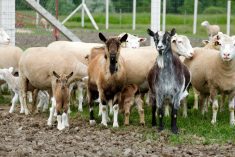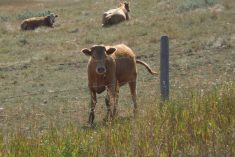Doing feed tests now, at the start of the feeding season, will allow producers to develop a strategy to ensure all categories of cattle in the herd are fed to their production goals and extra costs are avoided.
“Livestock feed supplies are going to be tight in some areas of Alberta, while in other areas, quality may be an issue,” said provincial beef extension specialist Andrea Hanson. “As such, testing feed stuffs that are to be fed this winter is important as you need to know what nutrients are available.”
Read Also

Farming Smarter receives financial boost from Alberta government for potato research
Farming Smarter near Lethbridge got a boost to its research equipment, thanks to the Alberta government’s increase in funding for research associations.
The formulation of a ration depends on the nutrient composition of the forage, and the only way to accurately determine that is by sampling and testing the feed.
“Using last year’s feed tests, or even worse, using a provincial average for a feed’s nutritional content, isn’t realistic or useful,” said Hanson. “While physical attributes are part of feed quality, they don’t tell the whole story. A bright-green colour does help indicate the feed was put up with little or no rain, and that the mould level is little to none, but it doesn’t tell much more than that.
“Protein and energy content of the same hayfield can vary greatly depending on when it was cut.”
For example, brome cut very early in the season could have 18 per cent protein but only five to six per cent if cut late.
Protein requirements of a cow in second trimester of pregnancy (minimum of seven per cent) is significantly different than when she reaches the third trimester (nine per cent) or lactation (11 per cent), said forage-beef specialist Barry Yaremcio.
The most important information in a feed test is protein, energy and fibre.
“A basic forage analysis will list the moisture content of the feed stuff, energy as total digestible nutrients (TDN), net energy (NE) and/or digestible energy (DE), crude protein values as well as calcium, and phosphorus, magnesium and potassium,” said Hanson. “A basic analysis should cost less than $50 which is much less than the cost of a round bale of feed, let alone the possible savings from using fewer bales of hay mixed with lower-quality forages.
“The more advanced analytical packages will provide more details about the feed depending on what’s requested. If an early frost or crop stress have been experienced in the area and there are concerns, a nitrate test may be very beneficial as would a toxin test.”
Getting a representative sample of the feed to test is important in feeling confident with the analysis, said Hanson.
“If sampling bales, samples need to be taken from a number of bales (at least 15 to 20) from different areas in the field and then mixed into one sample,” she said.
That work is made much easier with a commercial forage sampler and some local agriculture service boards or forage associations have equipment available for loan.
“Use plastic bags to ship the feed so that an accurate moisture level can be determined. If sampling from a silage pit, rub the loose material off the face before taking the sample from packed material from the freshest part of the silage face, and from several locations in a ‘W’ or ‘M’ pattern. Mix the samples and pack tightly into a plastic bag with as little air as possible.”
If samples won’t arrive at a lab right away, they should be frozen.
“Finally, if you want a sample of the swath grazing feed, take a tub and scissors out to the field and pull various samples from the swath from locations all over the field,” said Hanson. “As the samples are pulled, cut the feed into two-inch lengths and mix in the tub. From the total sample, stuff a large zip-lock bag with a representative sample of the feed for analysis.”















